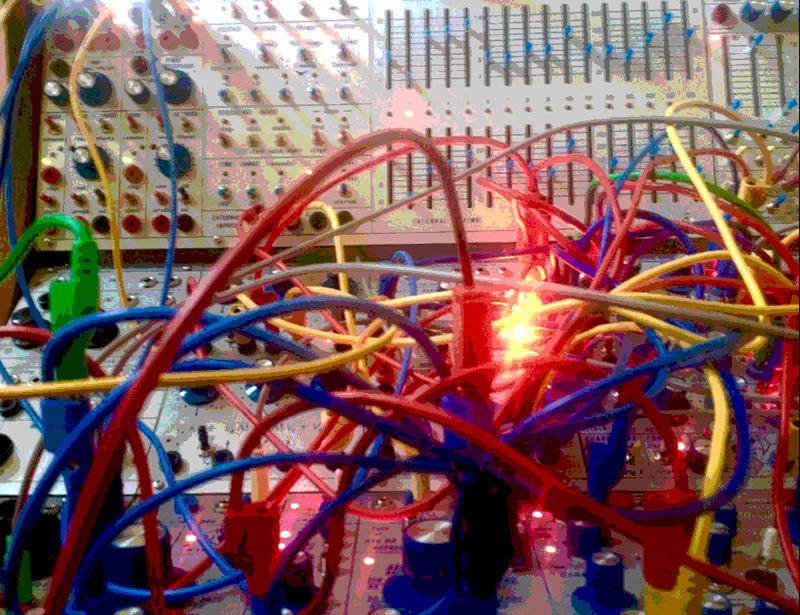
3 years ago I started to gather some music from composers playing Buchla instruments and 2 volumes of BUCHLAÏSMS appeared as a companion to my first choice in our I.T.A.T.I.O.M. chapters dealing with Inventors Talking About Their Instruments Or Modules.
https://modular-station.com/modulisme/itatiom/buchla/
Those 2 volumes, offering about 7 hours of music were already a mammoth of a collection but I had a feeling that many players were missing. My purpose was to respect the historical side while showing today’s creation.
Thus the last few months have been very studious, spending a lot of time pulling strings, trying to find new users of the instrument, re-launching or convincing some of the best-known to participate to an hommage to Buchla. Of course I haven’t managed to get everyone on board and no worries as I’m happy to rest assured that some do not need our support…
Nevertheless 5 new volumes filled with creations made on purpose are now ready.
BUCHLA – often labelled as the Stradivarius of Synthesizers – is one of the most innovative « musical vessel » ever designed, whose extent of the sound spectrum does not seem to belong to this world and the logic lies apart from everything that may have existed before its creation. The Buchla synthesizer is named after the electronics pioneer Donald “Don” Buchla, who manufactured his first modular synthesizer with the avant-garde musicians Ramon Sender and Morton Subotnick, the founders of the San Francisco Tape Music Centers (SFTMC). Both were looking for an engineer who could implement their ideas and requirements and found this person in Donald Buchla, with his extensive musical and technical expertise. In 1963, they eventually managed to achieve together what they had been working toward for years: an analog, modular synthesizer. The Buchla Series 100.
As you know Modulisme has paid a lot of tribute to SERGE, celebrating its 50 years of existence with dignity. So I thought that since Buchla is the one that started it all for me + my favourite system, it was high time to add some entries to our « Buchlaïsms » series. Those were chapter I and II, 5 more will appear until December.
https://modular-station.com/modulisme/session/21/
+
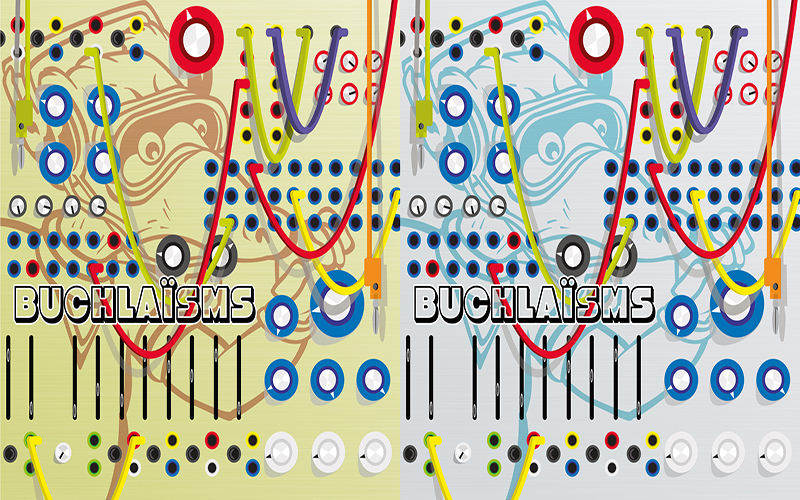
Don Buchla initiated the 100 series Modular Electronic Music System in 1963 + the Easel in 1973 so let’s celebrate in a grand way…
01. Philippe Petit – Appendix 2 A Reassuring Elsewhere (10:11)
« A reassuring Elsewhere » is a trilogy that takes us through a looking glass in hope of reaching a wonderland where we feel reassured because nothing is as it seems…
A kind of gesture towards vertigo but also a hand-stretched towards a ‘reassuring elsewhere’.
« A reassuring Elsewhere » is being released by Oscillations records run by Gabriel Prokofiev, in parallel to his Nonclassical charity label. Chapter I appeared in November 2022 ; Chapter II has been released in Novemember 2023 and Chapter III is to become public in 2024.
https://oscillations-music.bandcamp.com/merch
I believe it is important to insist on the importance of creating a special relationship with my instruments. The strength of the modular synthesiser or any new, prepared/modified instrument is precisely that it is not totally considered as an instrument for which one has to follow a playing technique, a method; the modular synthesiser obliges one to learn indissolubly linked to invention. Each technical problem is overcome by thought, by patching, and not by a reflex acquired to reproduce what is read in a score.
I advocate the marriage of acoustic and electronic and prepared my piano and needed to find a perspective for these accousticisms, how to replace these sounds on an imaginary space canvas, how to make them live in a composition along with the Buchla. Patching accordingly becomes part of my compositional process and I chose to adapt the instrument and to prepare the patch that will enable me to achieve the musical colour I was looking for, or to find the precise sound that’s missing… This time in search of delicacy playing an oscillator into a Resonator while the piano Soundboard goes into the 230 Triple Envelope Follower allowing to simultaneously control the synth and play with QUAD and various Stereo movements and undergoing various transformations varying from Frequency Shifting or Filtering until it gradually leaves more and more room for electronics, sculpting sounds, textures, developing stories while composing instantly, like a craftsman “with his hands in the sonic mud”.
HANDS ON !

02. PRFRK (Yan Proefrock) – Valse d’Ana (03:41)
Geek and passionate about all musics Yan Proefrock likes to think outside the box. Video director and editor specialised on live music shows for the french television he learned classical piano quite young and started buying gear in the 80’s. He discovered modular synthesiser in 2016 and became totally addicted to it…
In 2020 he started the very first radio devoted to the genre: Modular Station.
Ana’S Valse is a mixed piano/Buchla composition, inspired by the richness and contrasts of the multiple facets of the personality of my youngest daughter Ana. Darkness, Wilderness, Smoothness, Gentleness, a whole range of contradictory emotions…
The Buchla synth has a very specific sound to my ears. Raw and organic sonorities, with rich harmonics and a lot of natural dynamics.
For now, my main Buchla instrument is the Easel K which I love to play and marry with other systems and soundscapes, but I’m also really impressed by the Buchla 100 system. I own the eurorack « RED PANEL » version.
I’m pretty much in love with the strong character, sinewaves and the FM of the 158 VCO and of course the mythical bongo sound of the Buchla LPG.

03. Felix Ahlström – Voile De Nuit (05:30)
With a background firmly cemented in music, ranging from contemporary to classical, Felix’s art practice extends to implement a diverse selection of disciplines including design and visual arts in favor of a complete expression of his aesthetic universe.
In loving memory of Nikki Ivory Nine – studiocat extraordinaire.
The piece is a snapshot of a moment during a very early summer morning when the night caves in and gives way to dawn.
To me, Buchla is less about the how it sounds and more about how it enables you to shape the sound and to find new compositional paradigms within a certain set of limitations. The Buchla provides me with a compositional playground that encourages me to break out old habits. Victor Hugo supposedly said something to the effect that ”Music says what can not be spoken but can not remain silent”.
The Buchla gives voice to music I’ve always felt but were never able to reproduce.
My favourite module is without a doubt the 266. To paraphrase the great Todd Barton: “there’s just something inherently musical about Don’s randomness that I’ve not been able to replicate elsewhere”.

04. Josue Arias – Mai mes (04:07)
Josue Arias is an eclectic and experimental artist and musician born in Madrid, Spain in 1971. At an early age he studied solfeggio, piano, and began to create his own sounds using analog synthesizers when he was only 9 years old. From the end of the 90’s he has focused his musical aspect on the audiovisual, devoting himself to the composition of music for documentaries, advertising and TV series and movies.
In the composition of this song for piano and Buchla synthesizer, the search is aimed at fusion. The fusion of timbres of two instruments that a priori may be antagonistic. Musically, I seek to convey the same thing: a dialogue that seems to be in a different language, but that achieves an understanding between the two parties.
I was always attracted to the Buchla synthesizer, even before I could hear it, because of its aesthetics. Especially the 200 series with its color configuration was something inspiring for me. Listening to Morton Subotnik’s records, I discovered his sound and was able to see the great expressive potential of the instrument.
I see and feel the music easel as an instrument in itself, powerful and with an expressive capacity similar to an acoustic instrument, so I tend to use it autonomously, whle my 200 system is, however, part of a bigger modular system along with the Driscoll /Serge.
I am always in search of new sounds, as a musician and as a sound designer. Sound itself is one of my main sources of inspiration and the buchla allows me to carry it out in a very direct way.
The most important module for me would be the 208, it shares the main part of the music easel and It contains most of the things I love about the Buchla concept: the lopass gates with their organic sound and flow, the timbre control from sine waveforms that allows with very little interaction to radically change the sound, the random generators, and finally the user interface, where everything is accessible and can be completely configured very quickly and easily.
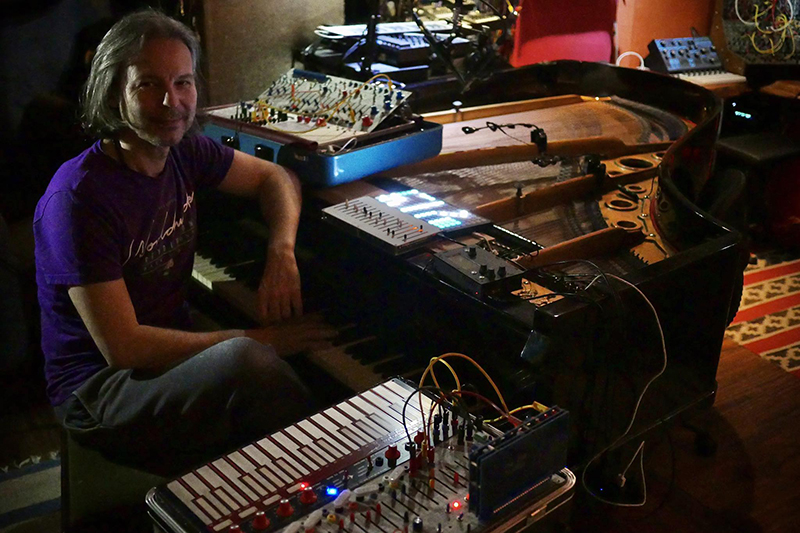
05. Suzanne Ciani – Concert Practice 2 (03:44)
© ℗ Ciani-Musica Inc / Musica International.
Pioneer of the Buchla World Suzanne Ciani worked alongside Don Buchla back in the early days and since then her work has been featured in countless commercials, video games, and feature films.
Created while I was practicing for a live Buchla concert. The concerts are called “Improvisation on Four Sequences” and the raw material I use are four tone rows that were documented in my 1976 paper called “report to National Endowment.”
I discovered Buchla instruments in the late 60’s. It was, as they say, love at first sight. There was a Buchla 100, the first one, at the San Francisco Tape Music Center, housed at Mills College. I met Don Buchla through a neighbor of his while I was still a student at U C Berkeley in music composition and went to work for him in 1970. I got to play a huge array of modules in his studio.
I like to use the system for live performance and I believe it was designed for that, in the tradition of all musical instruments.
I love so many of the modules, but I guess my two favorites are the 248 Multiple Arbitrary Function Generator and the 227 System Interface that allows voltage-controlled spatial movement of the sound, integrated with the music.

06. Benge – Euclids Wheel (05:22)
Ben Edwards is an English musician and record producer based in England. Known professionally as Benge, over the years he has amassed a precious collection of electronic synthesisers, drum machines and studio equipment which is housed in his Memetune Studio. From there he writes and records his own music (over 40 solo albums) as well as his many collaborations over the years under the following names: Volume (with Richard Lee and Paul Elliott), Tennis (with Douglas Benford), Stendec (with Paul Merritt), Oblong (with Dave Nice and Sid Stronach), Wrangler (with Phil Winter of Tunng, and Stephen Mallinder), Fader (with Neil Arthur), Creep Show (with Wrangler and John Grant), as well as his continuing work with John Foxx & The Maths, Blancmange, and Stephen Mallinder (founding member of Cabaret Voltaire).
Recently he has been furthering his passion for vintage studio equipment, expanding into TV and Video production, culminating in his ongoing TV series The Memetune Programme, now in its second series.
My first exposure to the Buchla was via Silver Apples of the Moon, and some pictures of an early 200 series system in Hubert Howe’s book Electronic Music Synthesis, that I read as a teenager. I have been deeply interested in modular synths ever since, particularly ‘vintage’ ones, my first purchase being a Moog IIIC which I bought in 1994. I come from an experimental artistic background, and the open ended nature of modular synths really appealed to me, and I was aware that the Buchla was the ultimate system for electronic experimentation. I bought a Paperface Serge in the late 90s, and ARP 2500 and Roland 100M cabs in the early 2000s, all at fairly reasonable prices, before they went crazy
I was always looking for Buchla systems and modules but they never came up for sale in the circles I mixed in (I’m based in UK), and so when the 200e series came out in 2004 I was very interested, but couldn’t afford a complete system. I held off for as long as possible, but eventually took the dive and bought a system, partly thanks to a friend who very kindly let me have a go on his system as he was quite local to me at the time. In 2011 I actually got a flight to Berkeley and met Don, and put my system together in person with him. I thought Don was a very interesting man when I met him. He was quiet and polite, but had a mischievous glint in his eye. I was staying in Oakland at a hotel and he lent me some modules and a powered boat for a few days to try out. I had spoken to him on the phone quite a few times before my trip, and he knew I had come over from the UK just to meet him and buy a system, but it was very trusting of him to suggest lending me the system so I could play with it at the hotel.
One of the VCOs (261e) had a faulty pot – the centre-detent didn’t work, so when I took the modules back to the workshop I told Don and he had a look at it and a listen to it and just shrugged and said “well you know where the centre is because you can hear the result” and that was that! I guess he was right! I bought the module anyway and every time I used it I remembered his grinning face as he put me to rights. I eventually ended up with an 18U cabinet and most of the e-Series modules. But to be honest I never really got on with it. It didn’t suit my working style as I tend not to like menu-driven things in the modular world, and I also didn’t like the memory system. To me it just got in the way. Also there was something about the overall tone that I didn’t get on with, it’s really hard to explain, but however much I wanted to love it, it just wasn’t for me.
At one point I ended up getting a Verbos 258 clone, then I managed to find a vintage 144 and I realised how good these older analog designs sounded, and that it was that I was missing in the e series, the vintage tone!
And that was when I realised I wanted a Buchla 100 more than anything else in the world. In 2012 I got lucky and a Buchla 100 came up. I “caned my cards” and sold off my 200e system and some other bits, and made the Buchla 100 mine. I was helped by Rick Smith and went to see him in Vancouver (which is where I recorded a full album on his Buchla 700, called Chimeror, the only 700 album as far as I know). I also lucked out with some more vintage modules from another US seller, and a spare cabinet from Rick that I swapped for some ultra-rare Buchla paperwork that I got in the Buchla 100 deal.
Suddenly I had a very original and complete vintage 100 system. It’s like all the hard work and research I had done over the previous 10 years all fell into place, the people I had met, the money I had invested in other gear, and the Synth gods smiled down on me.
Bear in mind that in 2012 there were no clones around, except for Verbos and the Cynthia LPGs in Moog format.
In April 2012 I posted on my blog about Buchla fonts and how hard they would be to recreate, as the typeface was not a computer-based one. I think I was the first person to discover the correct fonts for the vintage Buchla stuff (Grotesk Number 9) – correct me if I’m wrong though! Verbos and Eardrill did not use the correct fonts, even though they were fully sanctioned by Don. Don did not have any interest in that kind of thing – not even the 200e series had the same fonts, and still don’t.
Then in 2017 I worked with a highly knowledgeable technician in the US on getting some 144 modules cloned, using the correct fonts, and a US company to make the panels. They came out great. These were for my own personal use and I did not share them with anyone or make any more that the 3 I have in my system now.
And that was my journey to getting my Buchla 100 system, until that is, the cloned modules began appearing around 2018/19. At that point I was deep into the Buchla paradigm, and began to put together a 200 system, which adds a lot of functionality, but which however still lacks some of the raw power of the early vintage 100 series modules.
My next challenge was to build a large curved cabinet to house my cloned modules, and in 2021 I achieved a life-long ambition by building my dream 200 system in its very own curved walnut cabinet, painstakingly recreated from drawings and photos of vintage systems – including those contained in Howe’s book, thus closing a very satisfying circle.

07. Miguel Frasconi – Beyond One (05:36)
Miguel Frasconi is a composer and improviser who has composed operas, ensemble music, scores for modern dance, and also performs concerts of improvised music, both solo and ensemble.
Miguel specializes in 20th and 21st century repertoire music, and has been playing experimental glass instruments for over 45 years. He also plays keyboards, but these days in addition to composing, likes to improvise on modular analog electronics, most often controlled in other ways than using a keyboard.
Beyond One was created in May 2016 as an exploration of a repeated yet continually altered rhythm and bass sequences, plus a simple yet modulated melody played on the 222e tactile controller. Modulating the decay slope of each oscillator’s envelope with the 266e Source of Uncertainty was something I often used to give notes a feeling of live performance. The construction of the melody patch was designed for live performance. Sliding the finger from the bottom to the top of each ribbon of the 222e introduced an array of timbral modulations and feedback that could be precisely controlled in real time. This piece uses the individual oscillators on the 261e complex waveform generator to play the separate rhythm & bass lines, with the solo line using the entire 259e twisted waveform generator, with all of it’s timbral modulations controlled by touch. I hope it is easy to hear the physicality involved in the performance.
The first time I heard a buchla system was in the mid ’70s, when David Rosenboom had programmed a “wah-wah pedal” type filtering for Jon Hassell’s trumpet. It was controlled by the CV of an envelope follower driven by how loud Jon played. Simple but very effective, and Jon was able to play it as if it was part of his trumpet. I first heard a full Buchla setup when Don & David played two 200 series in a concert in Toronto, around the time they were working on the Touché together. I was familiar with the sound of the Moog, Arp, and Putney, but the Buchla sound was something altogether different. With all the vactrols and all the CV going around, it sounded like newly imagined acoustic instruments. I didn’t really hear a Buchla live again until I started working with Mort Subotnick in the mid 2000s, which was a whole other education in itself. A crash course on the Buchla system mindset!
It is difficult to say which Buchla module is my favorite, since I can’t help but see an entire given system as one instrument. That said, I can’t see any Buchla system without a 266 random generator, and, personally, I put all my live electronics through a Buchla mixer with their voltage controlled panning channels. Then there are all the other modules. Mort recently said that the Buchla system was designed so that one could build a brand new instrument for each new piece of music. Everything, even the tactile controller, could be looked at anew with each new patch.
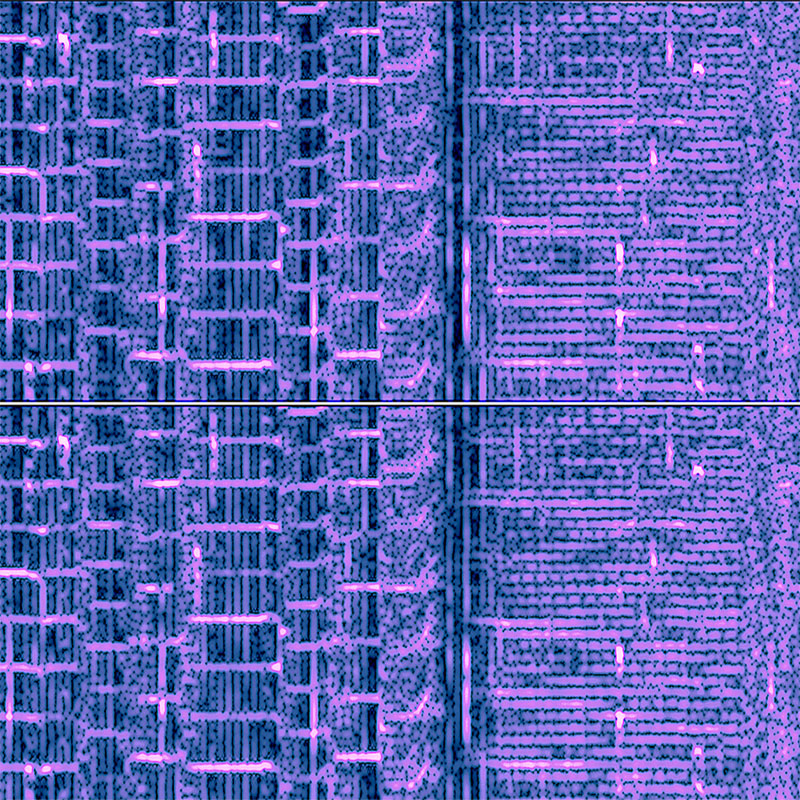
08. Jessica Kert – In the middle of everything (05:37)
Berlin based electronic musician and Techno producer, Jessica Kert loves diving into experimentation with her modular synthesizer.
Working in the famed Berlin synthesizer heaven Schneidersladen rest assured that she knows her ropes.
Peering her way through a dense forest of patch cables, feeling all these frequencies and with the love of the physicality, Jessica is playing her Buchla 200 with much dedication + she is constantly producing music and released her new album on the multidisciplinary arts collective Detroit Underground.
I have been attracted to Buchla for almost 10 years now. Through my day job at the synthesizer heaven Schneidersladen I was suddenly surrounded by all these eurorack modular systems and ther builders, so I started to learn how to play these instruments and read basically everything I could find about the history of electronic instruments in general.
Of course Don Buchla came across and when I started to study his instruments during the Corona lockdown times I realized that a lot of nowadays electronic music instruments maker`s had been inspired by his work. As far as i am concerned I was always more attracted to the West-Coast philosophy and to me it felt like Don`s instruments were exactly what I needed.
When I heard his instruments in real for the first time I just thought- Damn! need to work on my gain- staging. The sound was so powerfull, massive and cristal clear.
To me the Buchla 200e system is simply mind blowing. Although I have a huge knowledge of modular Eurorack systems I stood in front of it and just thougt- well, have to start from the beginning.
Especially when it comes to the tremendous possibilities of the control interfaces. Basically I have constant explosions going in my brain, also when it comes to creativity. Not sure yet what it will bring to my artistical vision but already know for sure that it won`t be stagnation.
If I have to pick my favorite module, it would definitely b the Buchla 223e. What I do love most about, is its physicality. You can control your Instrument on so many levels just with your fingertips. There is no need to think so much, you just go with the flow.
The System Interface 227e just opened a new door to me. The fact that you can hear the sound in Quad and the possibility to play with this is a very much exciting expirience. To feed in a signal from the outside world over the Mike Preamp is just awesome and very open minded.
Last but not least, the Buchla 210e Control Signal Router, which is such a helpful module to keep your Audio – and CV-control signals organized. Just by simple routing you can change your whole composition to something totally different.

09. Sam Prekop – Island (03:06)
Chief songwriter for The Sea and Cake, who also teamed up with John McEntire (Tortoise) or Jim O’Rourke, grew up in Chicago and has released 5 solo albums to date.
He loves to play his Easel and various other instruments to creates a singular sound inventive and warm. His distinctive vocals, guitar playing and work on modular analog synthesisers are inventive, delicate, and always bear his signature sense of melody.
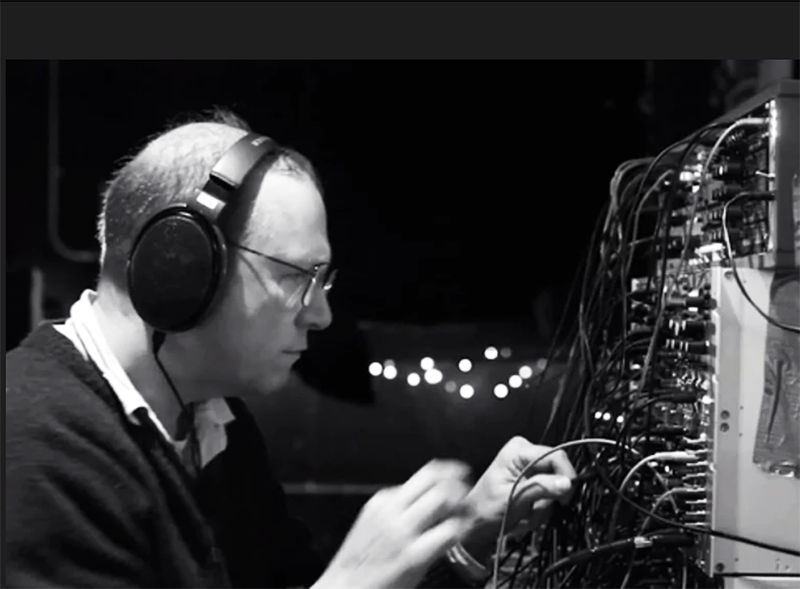
10. JesterN – Spirals #2 (06:18)
Alberto Novello a.k.a. JesterN’s practice repurposes found or decontextualised analogue devices to investigate the connections between light and sound in the form of contemplative installations and performances. He repairs and modifies tools from our analogue past: oscilloscopes, early game consoles, analogue video mixers, and lasers. He is attracted to their intrinsic limitations and strong ‘personalities’: fluid beam movement, vivid colors, infinite resolution, absence of frame rate, and line aesthetics. By using these forgotten devices, he exposes the public to the aesthetic differences between the ubiquitous digital projections and the vibrance of analogue beams, engaging them to reflect on the sociopolitical impact of technology in a retrospective on technologisation: what ‘old’ means, and what value the ‘new’ really adds.
He has assisted Alvin Lucier, David Behrman, Nicholas Collins and Trevor Wishart, completed the master Art Science Technologies with Jean Claude Risset, and graduated in Electronic Music at the Institute of Sonology, Royal Conservatory of Den Haag.
He worked for Texas Instruments, Philips Research, and Auro Technologies creating software for their audio applications.
The piece was created and recorded at the EMS studio of Stockholm using only their large Buchla System dating back to the 70s.
The piece is a Canon using the 4 Oscillators the system had. I tuned them and used a Japanese Scale with CV control from Expert Sleepers. I progressively build up an arpeggiator and finally deconstruct the temporal structure sweeping across the whole range at will.
Reverb from the great plate reverbs on the top floor at EMS studio.
I always liked the philosophy behind the instruments and the musicians that play Buchla. I think Don had a very musical sense beside his engineering knowledge. The first time I listened to Charles Cohen playing the Easel I was blown away by the patterns he generated and layers of sounds all sounded so musical and coherent, less rigid than with other machines.
I like to explore sides that I still feel being unexplored, which is very difficult of course. I like the possibility of combination, the complexity of path you can create, while still remaining interesting and surprising.
I like a lot the Programmable Complex Waveform Generator 259 which sounds always interesting to my ears, that Timbre part but also the various modulations, the Phase locking, the Harmonics can provide so many timbrical possibilities all in one module.

11. Nick Peck – Nucleotides (06:28)
Nicolas Peck is an American composer, keyboardist, sound designer, and audio director who has made a living as a sound designer/composer since the late 1990’s.
Many will know of his “Under the Big Tree” YouTube channel mostly dealing with electronic music but may also have heard his music without knowing it since he has been audio director of Disney Publishing Worldwide since 2012, and also focused on creating audiobooks and linear audio stories across the many franchises of Disney, Pixar, Marvel, Twentieth Century, National Geographic, and Lucasfilm.
I’ve been working on a new improvisational system for live performance. I was studying the work of Charles Cohen, who added rhythmic looping to the Music Easel through the 16-second delay pedal. The delay can time the Easel by outputting a clock signal that could drive the sequencer or pulser, allowing percussive elements to sync and build upon each other.
I loved the idea of building rhythmic elements on the fly, and wanted to find a modern-day equivalent to the 16-second delay pedal. I realized that I already had it, in the form of the 4ms Dual Looping Delay Eurorack module. This led me down the road of creating a relatively simple Eurorack processing system that would interface with the Easel and, eventually, a portable Serge system I am building. I added a Mutable Instruments Clouds to help create drones from the Easel, some clocking, a little mixer module, and a Klee sequencer I built some years back for more rhythmic control. My old Eurorack modules were being repurposed to interface with the Buchla system I now use.
I recorded the drones as one improvised performance, and then the rhythmic elements on top of it in another pass, then a final pass for some of the sound effects-type material. With enough practice, I want to be able to create the same type of music in a single pass, without the need to multi-track.
I’m from the San Francisco Bay Area, where Don Buchla lived and invented his instruments. I studied at San Francisco State University, which had one of Don’s earliest 100-series modulars. And then I went to Mills College, which housed the original San Francisco Tape Music Center Buchla that Don and Morton Subotnick developed. I would see Don at concerts at Mills all the time. So Buchla synthesizers were an important, integral part of the DNA of experimental electronic music in the Bay Area.
The first time I heard the Buchla 100 was at San Francisco State University. It was used for teaching the fundamentals of synthesis, because it had such a straightforward and simple design. I loved it, but as I got more experience I preferred the Serge system we had there over the 100. The Serge was much larger and more comprehensive than the Buchla 100. But once I heard the Buchla Music Easel and the 200 series, I realized that the sound of the instrument was as sophisticated as the Serge, and distinctive in its own way.
When performing in band contexts with other musicians, I gravitated towards various improvisational genres: traditional and soul jazz, jam bands, and so forth. On the contemporary electronic music front, I found carefully-composed, written out electronic music scores did not resonate with my compositional style. I once again focused on music that was made in the moment, learning from Pauline Oliveros and other fine teachers. That approach has continued to be my guiding principle. And I have no instrument that is better for electronic improvisation than the Music Easel. I can carry around a single, simple briefcase-sized device that can work as a solo instrument, or in concert with other improvising musicians. Having a unified, color-coded user interface allows you to learn one synthesizer, and learn it deeply. The Easel is an iconoclastic instrument, much like many of the musicians who love to explore with it.
My favorite Buchla item is not a module. It is the Music Easel. As mentioned above, the Easel is designed for live performance, and has an incredible sense of immediacy. The audio signal flow is relatively simple, but the control voltage possibilities are what make it speak with a unique voice. The card slot allows for so much expansion, and my favorite module for that slot is the Prism Circuits envelope generator board. It gives you another envelope/LFO, white noise, and more random voltages. I also have built the Portabellabz Easel cards, and love them too.
I do have a Buchla 200e Skylab, but these days it doesn’t stir my imagination the same way that the Easel does. The whole point of modular synthesis for me is to get away from the computers that fill my life. The 200e modules are computers, some with menu-diving that take away from the directness and real-time improvisational aspect for me. I have built a couple of 200 modules to get more control voltage capability for my Skylab, but it is not getting a lot of play. I did release an album a couple of years back called Qka, that was exclusively created on the Skylab. But the system is incredibly expensive, and I’m not sure that I’m using it enough to justify the cost. One of two things will happen: either I will sell it, or I will build more 200-series DIY modules and use the 200e modules as the center of a larger system. Time will tell.
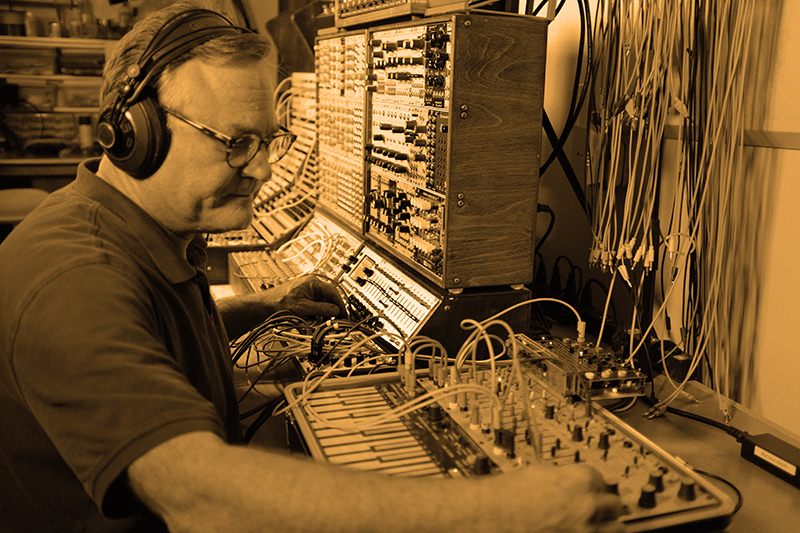
12. Daniel McKemie – Sample Systems (17:04)
Mastered by Ryan Ross Smith.
Daniel McKemie (né Steffey) is a composer, percussionist, and multimedia artist based in New York City. His music focuses on the boundaries of musical systems, both electronic and acoustic, that are on the verge of collapse. The power in the brittleness of these boundaries, often dictates more than the composer or performers can control, which is very welcomed.
Written on a combination 100/200 Buchla system, this work is the culmination of exercises while studying with Morton Subotnick in the Fall of 2022, with lessons focusing on technology and the culture of music. He asks, “if everyone has access to the same tech, software, hardware, and plugins, how do you use them to create something that is your voice?” Not so different of a conversation that a composer has when writing instrumental works.
We discussed the orchestra in depth and looked at the Buchla synthesizer as exactly that, a template for building instruments to be performed and recorded, and the results arranged and orchestrated. While Mort’s latest works involve being in the box entirely, with Ableton Live and Max/MSP, his approaches to composition and performance have had a common thread since the 1960s, some of which he developed during Silver Apples of the Moon. In search of trying to make what he would call, “a new new music”.
Regarding form, the sections of his pieces are modular. He cites Earle Brown’s Available Forms as a great descriptor, though worth noting that Brown’s piece was not directly influential as Mort had not heard it until several years after developing his own ideas, which involves making sections that can be interchanged and its parameters controlled and “conducted” in performance. Also taking an approach as to how a piece moves forward, for example by making decisions on whether the next event will be the “same, similar, or different” than the one, or ones, preceding. A simple rule of development that becomes increasingly complex as the piece grows!
Another guideline is maintaining a policy of performing everything. If you trigger or sample anything from the instrument, or elsewhere, it should be something that you perform and record yourself, when applicable; with the same seriousness as you would when recording a classical piece in the studio: doing multiple takes, editing them, and ensuring the highest quality result. This adds the human element, your human element, into the music.
I took Mort’s suggestions and approaches, coupled with my own, on a weekly basis and crafted what would eventually become this work. The opening gamelan sounds are taken from the Lou Harrison collection that I had recorded while at Mills College. These are performed with some sampler processing in Ableton and captured to a set of audio files that are triggered and routed into the Buchla system. The influence here was taken from Mort’s techniques in using four track tape and envelope followers to create structures and events, as in his piece Sidewinder, and many other works of his that employ the voice as a control mechanism for the Buchla.
The knowledge passed through these lessons will prove to be invaluable to me for a lifetime and I am incredibly grateful for the time spent with Mort discussing music and its history, technology, composition, the orchestra, and his stories about American music and art. This piece is dedicated, with great admiration, to him.
The first Buchla I heard was the original 100 system at Mills College when I was a student there. It was Pauline Oliveros’ recordings with the instrument that sparked my interest, some of which were only available in the Mills library archives at the time. It was in studying her techniques with tape delay that led me to her pieces with Buchla, specifically Alien Bog, 50/50 Heads, and 50/50 Tails. It would not be for another handful of years that I would begin to work more closely with synthesizers, but the exposure to these recordings and the early instrument at Mills certainly solidified my gravitation towards 100 series modules!
I always saw the Buchla 100 and 200 systems as having a unique place in the world of modular synthesizers, primarily because of its lack of interest in being closely tied to the western canon. It really stands as a portable test equipment lab that one would find in electronic music studios of days past. The instrument was created as a collaborative project between musician and engineer, and built to purposefully avoid the characteristics of classical music. To compare with Moog’s oscillators being switchable like that of pipe organ stops and having a keyboard to control. This is not a value judgment against other manufacturers or designs at all, but the unique approach of a Buchla is what speaks to me as an artist. I am a studied classical performer and composer, and I cherish that practice very much, but to experiment further, it is often nice to get out of that mindset as much as possible, when needed.
The Buchla 130/230 Envelope Follower modules is an incredibly powerful tool for contour and shaping in a hardware system. Long before I settled on using a Buchla, or any modular synthesizer, envelope followers were in common use in my music. It adds the human element and nuance that is very important to me in electronic music. I had a great conversation with Mort about the envelope follower, as it came about when he and Don were discussing the possibility of different controllers, with Mort having the idea of using his voice to generate control voltage signals. Don agreed that he could build something and soon returned with what became the 130. What none of us could confirm, is if this was in fact the first envelope follower for use in a musical context? Regardless of the history, it became a seminal part in Mort’s music as it has for so many others. There is hardly a time when working with a Buchla that I don’t use it.
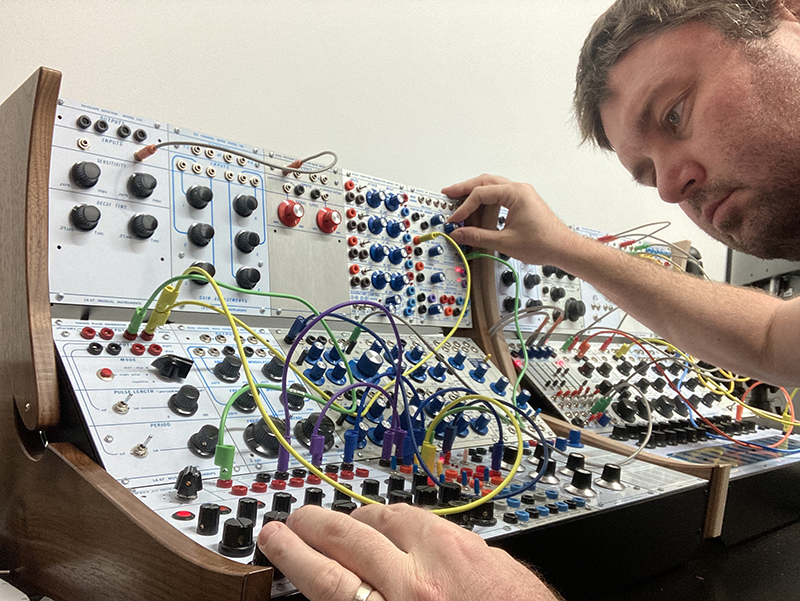
13. Sig Valax – Strolling (06:04)
After attending the class of electroacoustic composition of Christine Groult at the Conservatory of Pantin (DEM) Sigolène Valax realizes electroacoustic and radio pieces, sound creations for live performance.
She is interested in wild lutheries and explores experimental improvised music with Vierge Noire, Elek Ember, Seuil Optique, Sauges, Mesce Basse, and Lucus Furrina.
I’d like to retrace my steps back to the Buchla synthesizers and celebrate these magnificent machines that so vibrantly catalyse a form of freedom and creative power. So to follow in their footsteps I’d talk about the body, an organic body in which all the colours of the rainbow are hidden. First I discovered its skin, then little by little its structure and sensuality. I envision the Buchla synthesizers, particularly the Music Easel, as a naked body. I have the sensation that its flesh curves in the dampness of the electronic folds, and this nudity calls for very special attention. The instrument is at times shaggy, noisy, rumbling with fury and at other times fertile in harmonics, leaping from ritornellos to rhythmic or tribal sequences.
It develops an unparalleled vocabulary with precision and tactility for us humans who caress it.
When I first heard the sounds of the Buchla, I felt as if I were in a state of grace. A clamour of summer ardour touched me, continued with fiery tones and struck my sensibilities right to the bone, along my spine and neck. The Buchla’s song sought my blood and I offered my veins. There was something bewitching, I was bitten by its spell.
For me, the Buchla system is a raging body that generates full-lipped waveforms and complex frequencies that vary in amplitude with powerful beats. It oscillates between fragility, throbbing sway and hardness. There’s also a martial aspect to learning to control all these tensions, resonances, filters, amplifiers and attenuators. The visceral dimension of the cables forces me to create a space of concentration in my skull to organise the multiple combinations. I juggle to find the tessitura I’m looking for, tapping, erasing or rivetting the aural behaviours and emphasising one sonority rather than another. There’s a relentless sunshine in my pupils as I trigger the different modules of the system.
It’s a beautiful desire to compose, a pleasure to weave the electronic material at my fingertips and it’s the synthesiser that teaches me to flutter. I appreciate the possibility of playing with random forms mixed with a rigour that is sometimes tough. The Music Easel doesn’t allow itself to be boxed into a cramped, formal design; it imposes itself through the uniqueness of its internal logic. Thanks to Don Buchla’s art, I feel an intoxicating form of perception that abolishes the antagonisms between mental control and playing with the hands.
My heart is won over by the Music Easel for its tactile and sensory dimensions. I let my fingertips guide me to control it. Barely touching the keyboard gives me physical sensations and creates a state of gestural and compositional readiness. It seems dedicated to creativity through precise instrumental gestures. The faders are extremely delicate, and the jumpers and banana plugs give another breath of fresh air to my playing. The whole nature of this modular instrument encourages me to continue my investigations to tune myself flexibly to its bewitching charms.
It’s a game of accordance with the warmth of the tones, the modulation of frequencies to give meaning and orchestrate the Control Voltage/Gate. This allows me to approach the modular system in a different way and in a way that is ever more sensitive to the characteristic sounds of the Buchla. By its very presence, the Music Easel provokes the beauty of an epidermal, tactile and sensual musical imagination.
Many thanks to Yan Proefrock for lending me his Music Easel.
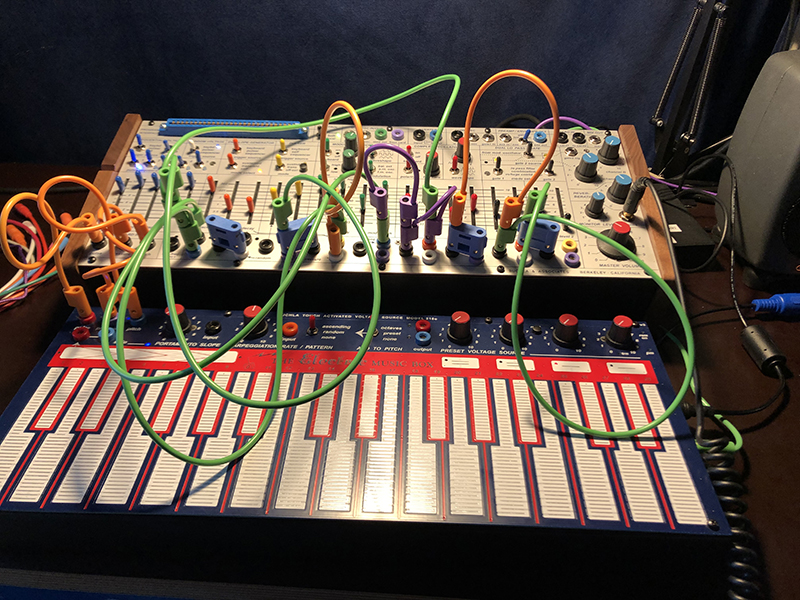
14. Joel Davel – Fire Cocoon (03:23)
Joel Davel is a well-known percussionist exploring the field of adventurous music, writing or performing for dance, contemporary ensembles or other luminaries such as Paul Dresher, Terry Riley, Fred Frith, Alvin Curran as well as many younger composers or chamber group…
As an instrument builder, Davel is known as a technician and collaborator of over 20 years with Don Buchla.
Asked to create accompaniment to a dance eventually called Chrysalis Dreams, I turned to an acoustic resource: A superball engaging a timpani head and with a cymbal on it for extra resonance and color. It’s in part a nod to the “Métallique” gong speaker used with an Ondes Martenot, but mostly it’s just a technique we modern percussionists have been employing for many years to coax as many interesting sounds out of objects as possible. The timpani head and body do most of the interesting work here. It’s in conversation with a similarly inspired sound from software synthesis controlled by the Marimba Lumina. I’m always looking at acoustic instruments and performance techniques for inspiration and – though not used here – my first piece with a Buchla 200 system focused on employing Buchla 230 modules with its envelope followers attached to percussion to accompany live theatrical readings. My first thoughts on creating a new piece start with whatever resources I have and my first choices are often acoustic. Though time and resources being what they are and keeping in mind how I might perform a piece live, I almost always lean on the Marimba Lumina to fully realize both my live and recorded work.
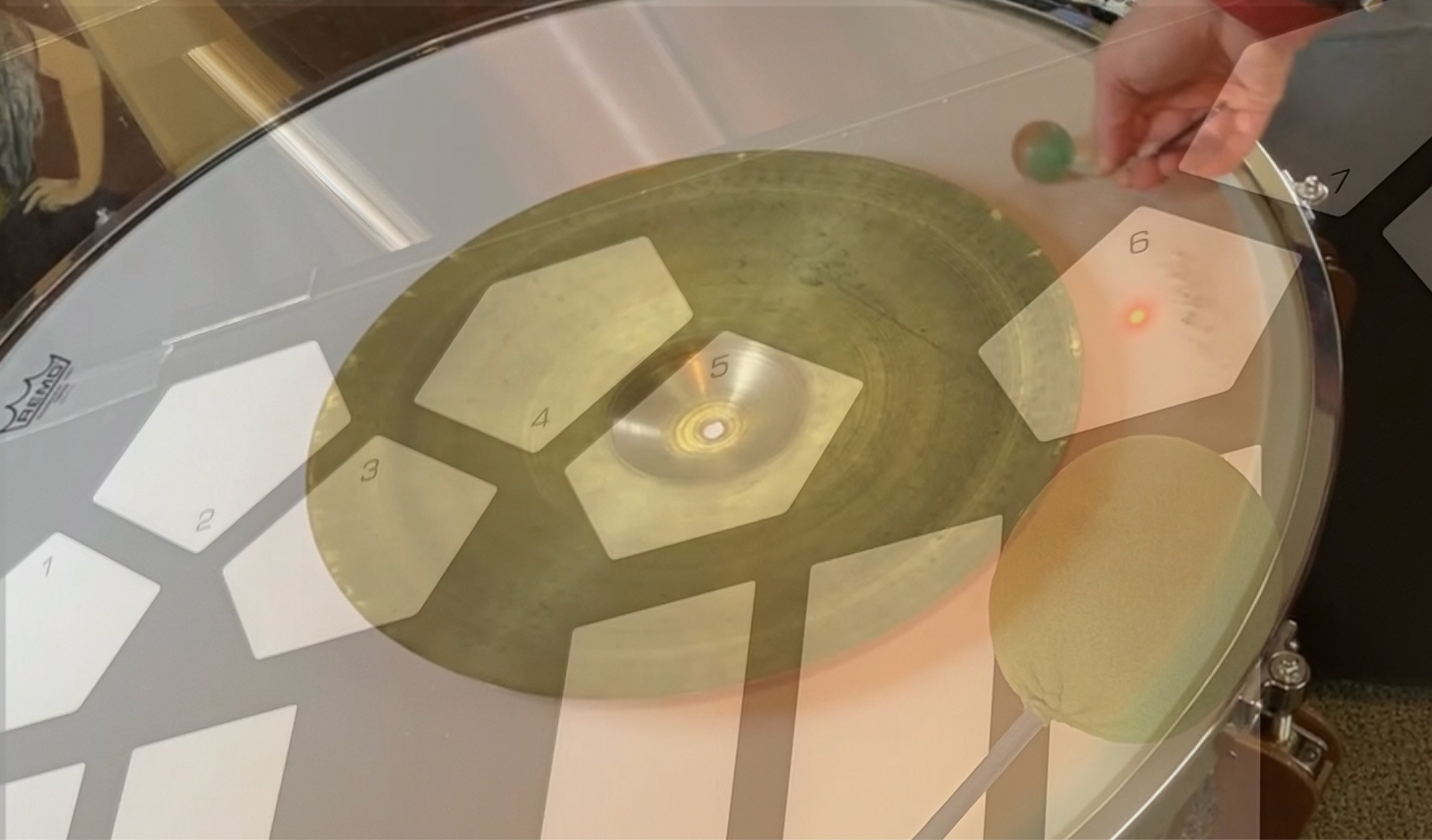
15. Rafael Timoner – Dranken String Quartet (Staccato Attempt) (04:24)
Multidisciplinary artist, with extensive experience in visual arts, with a vital need to experiment and explore new techniques, in the last 10 years dedicated to modular and video synthesis, having participated in recent institutional exhibitions with large installations integrating sculpture, sound and video.
The piece for this “Buchlaïsm” arose with the intention of taking advantage of one of the most obvious characteristics of the System 100: the imperfection and difficulty of keeping its oscillators in tune. It is a conceptual composition in which an imaginary quartet of drunk musicians tries to follow the tone and tempo of an equally imaginary and somewhat random composition. Looking for a certain tension and restlessness with out-of-tune notes that come and go with a choppy and imperfect rhythm, which I have ironically called “staccato attempt”. I have tried to synthesize sounds that recall the snapping of the strings and the touch of the fingertips moving over them, with all, I wanted to create a decadent or marginal atmosphere: A scene that I previously visualized as a painting and from that image I developed the patch that I later recorded as an improvisation.
Attracted mainly by analog, discarding everything digital, watching a video about the module 158 by Catalyst Audio. Totally raw, vintage and brutal. I have never found anything similar in Eurorack (Well only Serge by R*S, my other system). It took me a long time to get it, more than a year. In the end, I got rid of everything to build my Buchla 100 based Eurorack system with modules from Catalyst Audio, Buchla Red Panel and TTMC (Tokyo Tape Music Center).
These days only the Buchla and Serge can inspire and motivate me. Although the Buchla 100 is somewhat complex because of its more primitive concept, it reveals its personality little by little and the system is constantly surprising you. It is more difficult to get what you are looking for, but many times, on the fly, incredible surprises can occur.
Both Red Panel and Catalyst never went further than six modules before disappearing, thus I searched and found the TTMC option. They have produced practically all of the modules of the system 100. I am rediscovering new feedback techniques that are not as obvious as for example in the Serge system, but both the 185 Frequency Shifter and 111 Ring modulator modules have opened up infinite possibilities for me. Perhaps I would say these two modules together with the Sharp Cutoff Filter (module 191) and the last one I got: the 10 Channel Comb Filter module 295 are my favorite ones.
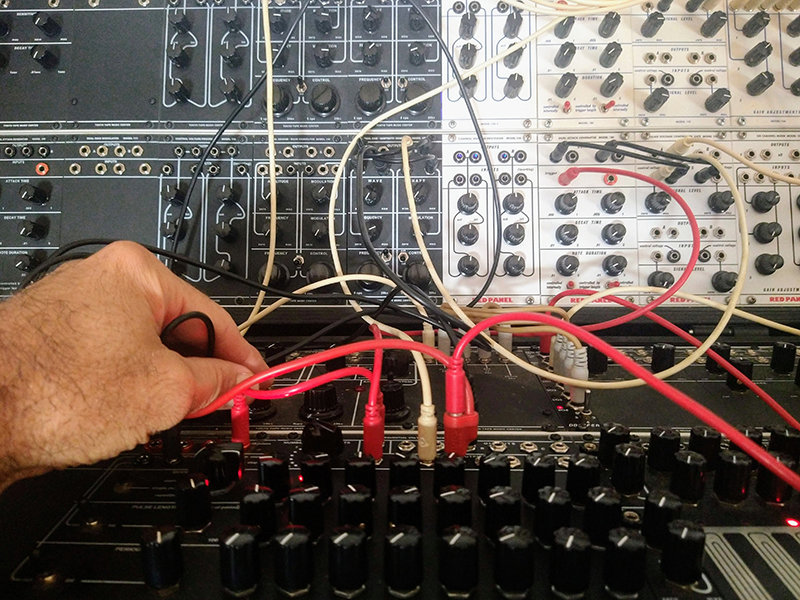
16. James Plotkin – Improvisation (08:56)
Plotkin is well-known as a highly respected engineer and producer, and spends his week mastering and mixing releases for artists of all professional levels.
He is an American guitarist and producer known for his role in bands such as Khanate and OLD but with an extensive catalogue outside these bands. He has played guitar for Phantomsmasher and Scorn and continues to remix tracks for bands such as KK Null, Nadja, Sunn O))), ISIS, Pelican and Earth. He works in the genres of grindcore, industrial metal, noise music, drone metal, dark ambient, digital hardcore and post-metal. When he isn’t playing his guitar he loves to experiment on his Serge and Buchla systems.
I try to avoid prefabricated ideas when patching and let the piece develop on it’s own accord. Most patches start as a simple experiment centered around a single module, and wanting to explore the possibilities of that module. Inevitably, once I start to enjoy what I’m hearing, additional ideas are formed, and the patching continues until I’m satisfied with the results.
I listened to a lot of early experimental music in my young adulthood, and was particularly drawn to Subotnick’s “Silver Apples of the Moon.” Being a young musician meant that I was broke most of the time, and could barely afford the gear I needed to do what I was doing at the time. Once I could finally afford an Easel, I was instantly hooked – it became the gateway drug to a full 30u system. To my ears, Buchla is a truly unique monster – both vintage/classic and modern in sound, instantly recognizable in most cases as it has it’s own sonic character, and the designs makes patching a lot more fun than with most other systems.
I don’t have a method of working that’s set in stone. Typically, I won’t even start patching with the idea of realizing a full piece – it starts with the desire to try and get “more” from a specific module, and inevitably develops outward. For whatever reason, I try to keep my Buchla patches within the system – I will occasionally introduce non-Buchla modules into a patch for tasks such as psychoacoustic processing, or drum machines for beats, but for the most part (and I’m not exactly sure why this applies to my Buchla system specifically), I like to keep it homogenous when working with Buchla gear.
The Source of Uncertainty will always be my favorite module, with the 250e DAFG as the runner-up. I’m devoted to controllable random generators, and the SoU gives patches life and sometimes unexpected evolution. A stale patch can become an electric organism when the SoU is introduced. At one point I had 3 of them in my system, but admittedly, it was overkill.
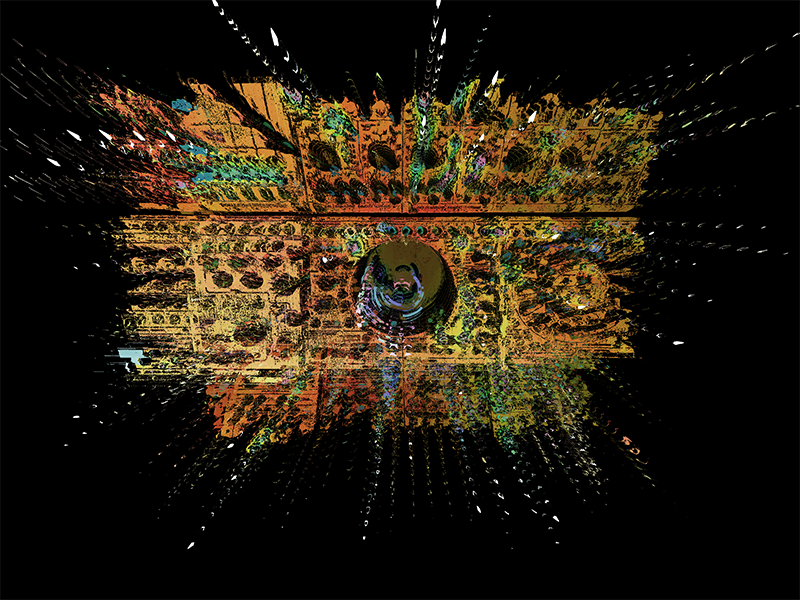
17. Ben Carey – Manifold (10:22)
Ben Carey is a Sydney-based composer, improviser and educator. He makes electronic music using the modular synthesiser, develops interactive music software and creates audio-visual works. Ben’s research and practice is concerned with musical interactivity, generativity and the delicate dance between human and machine agencies in composition and performance.
Manifold was performed using my 200e system (a modified Skylab), and an Akai GX-4000D Reel to Reel tape machine used as a stereo tape delay. The track relied heavily on the 225e preset switcher, and the sequencing capabilities of the 250e. Designing complimentary preset patches on the 225e, ones that would interact rhythmically with the fixed speed of my tape delay, was the goal here. There are 5 voices in the patch, which I’m mixing manually using the 207e. I was inspired by beating resonances between closely related tones, natural sounding percussive tones and deep resonances from the filtered 259e. My role performing this was quite high level, focused on switching presets, and end of chain mixing in the 207e.
I’ve always been interested in the history of so-called ‘West-Coast’ design philosophy in modular synthesisers. As a user of both Serge and Eurorack Systems, Buchla seemed like the next frontier for me, especially given the modules I’m most attracted to in the Eurorack ecosystem stem from Buchla’s original designs. The first time I spent any time with a Buchla was on the 200 and Easel systems at the Melbourne Electronic Sound Studio (MESS). The depth of the oscillators, especially for FM, blew my mind. Whilst the 200e doesn’t have the same quality of sound, the approach to modulation, performance and sound design comes from this lineage, with the addition of some incredible digital control.
I’ve been using my 200e solely in the studio at present, as I haven’t had the opportunity to perform live with it yet, however it lends itself perfectly to live performance. The 223e touch surface, and the preset management of the 225e are incredibly powerful. I find it can go from very a precise, deliberate patching approach to full-blown experimentation very easily. The ability to come back to sounds and processes that have been designed, even after lots of experimentation, allows me to move between these two poles quite seamlessly.
In the 200e, I think the 250e Dual Arbitrary Function generator takes the cake. It’s extremely flexible, performable as well as deep and intuitive in its design.
In the original 100/200 format, the family of analogue oscillators are very special, ranging from the raw power of the 158, the flexibility of the 258 and the complexity of the 259. All have their strengths, as well as limitations.
I also really enjoyed playing with the 296 Programmable Spectral Processor at EMS, this is very special. It has such a characterful sound, and a sweetness to the resonances.
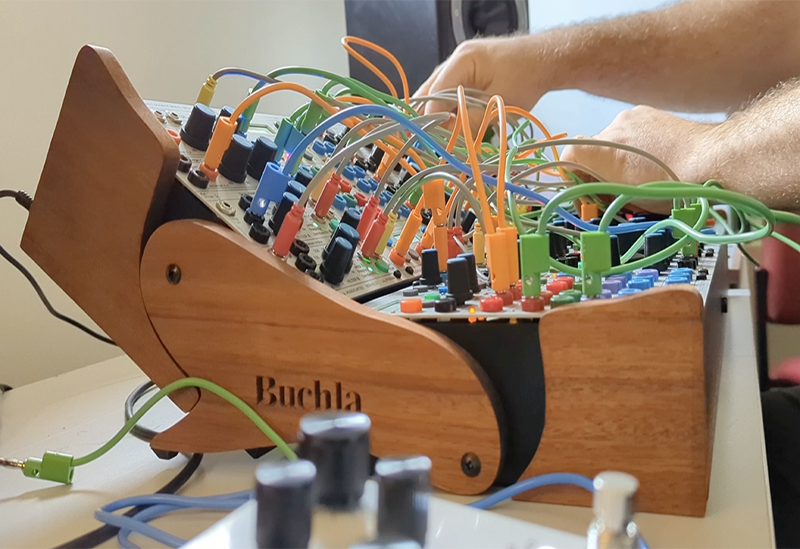
18. Thomas Dimuzio – Foldings XII: Haggler (7:09)
Thomas Dimuzio is a musician, composer, improviser, sound designer, mastering engineer, and music technologist residing in San Francisco, CA. His music is like a sonic excursion that transports the listener into other worldly aural realms.
His recordings have been released internationally by ReR Megacorp, Asphodel, RRRecords, No Fun Productions, Sonoris, Drone Records, Odd Size, Seeland, Monotype Records and other independent labels. Among his collaborators are Chris Cutler, Dan Burke, Alan Courtis, Nick Didkovsky, Fred Frith, David Lee Myers, ISIS, Matmos, Wobbly and Negativland.
I have an ongoing project called Sculpting Electric where I’ll spend days building complex patches between Buchla 200e and 200 systems with the intention to facilitate live in-studio compositions. This particular Sculpting Electric patch is themed and titled “Foldings” and seventeen variations were recorded; four of which were hand-picked for Modulisme.
My Skylab is a performance system that’s evolved into a well-integrated selection of modules interconnected by a fixed patch so that the system is immediately playable and as versatile as a musical instrument. The case also folds up while patched which helps with setup and breakdown at shows.
My other systems stay in the studio and are often unpatched and ready for exploration. In the studio my favorite patch is no patch at all.
The versatility of Buchla systems is without boundaries and often leads to new epiphanies about how sound is created and controlled.
I have a soft spot in my heart for the 272e Polyphonic FM Tuner which is essentially four CV-controlled FM radios, as well as a loving testament to John Cage. Pulling sounds out of thin air is only half as fun as shaping them with envelopes and LPGs. My 10U SkyLab system houses my favorite modules overall: 272e Polyphonic FM Tuner, 259e Twisted Waveform Generator, 281e Quad Function Generator, 292e Quad Dynamics Manager, 267e Uncertainty Source, 207e Mixer/Preamplifier, 258B Dual Oscillator (modded by Mike Peake), Vedicscapes Megatron Generator Model 618, Northernlights Modular hTM Trommelmashine and hTT Time and Triggers, Studio.h Control and Signal Router and WPA Program Manager, and 2 Zorx Ribbon Controllers.
A potent hands-on portable powerhouse!
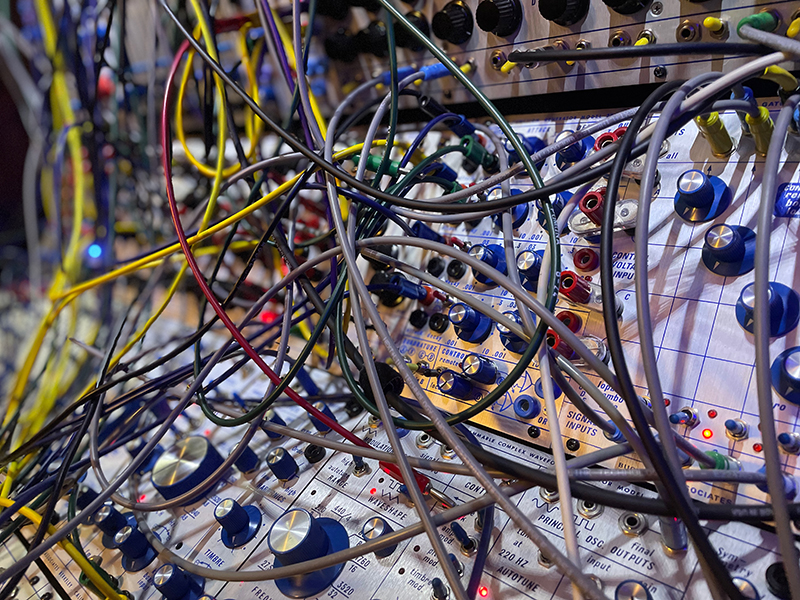
19. Ernie Morgan – Mono Mélodies 2 (07:38)
Ernie Morgan died in 2016.
He got his Masters degree from Mills College in 1971, then moved to UCSD, where he worked with the Buchla synthesizer. In the late 70s, he played with the psych pop group, The Strawberry Alarm Clock…
Also made on the UCSD Buchla in 1973 or maybe 1974, using the Buchla 100, Ernie had developed a patch where he traced some relevant aspects of a pre-existing tape, and derived control voltages from that, which controlled other oscillators. This piece starts out with one kind of continuous texture, a contrast to the earlier Monomelodies piece. Soon things get thicker, and many kinds of fragments come in. These build up to a rather complex texture, which gradually thins down to a coda of soft fragments, alternating with silence. (Warren Burt / SEPT 2023)
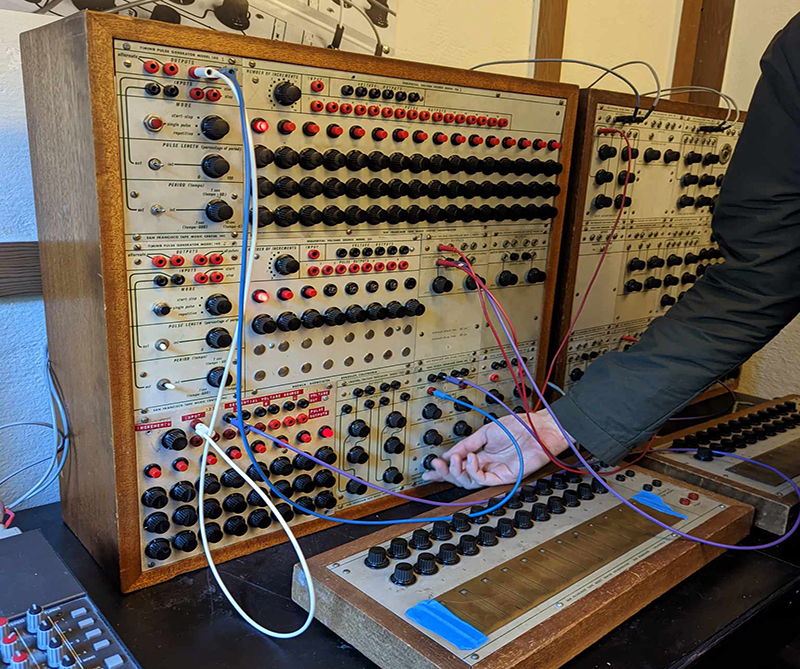
20. Ondřej Jurčík – KUPÉ (04:08)
Ondřej Jurčík comes from Olomouc city, in Czech Republic.
I commute daily by a train and I mostly intentionally – but sometimes unintentionally – reflected and interpreted the sounds I hear while being on the train, waiting on the railway stations, listening to the conversations of other passengers and machines, vehicles, tools of workers.
I find it quite meditative and this piece is an audio picture of all of that static movement.
I have been attracted to the electronic musical instruments since childhood, because I heard their sounds in a lot of pop music that my parents listened to. When I bought my first semi modular synth, I was looking for patches as an inspiration and a tool for learning more about the instrument. There was a YouTube video with a title SEEKING BUCHLA, where someone made a self playing patch on Korg MS-20. I searched, what does the word Buchla mean. So it was partially by chance how I found out what and who Buchla is.
Soon afterwards I was introduced to Jan Jiskra (MO-DU), Czech artist who showed me his BEMI Music Easel. I was mesmerized by the Easel immediately – by its sound, interface, architecture, very playful design. Thanks to this event I started to find more information about Buchla instruments and artists who have been playing them. The music was so unique, original and real. By real I mean that I could hear the relationship between the artist and the instrument, I could hear the human experience of creating musical art.
My Easel system consists of 208, 257, 216. So it is not the traditional layout of the Music Easel. However I find this combination of modules more useful in sense of CV processing possibilities. I also use Portabellabz ToolBox card, Triglav Modular Clockwork card and the “Serge-esque” modular synth Phenol by Kilpatrick audio. Phenol gives me the possibility of CV panning and coloring the sound with noise. I like to use my system like I am looking at something through microscope, being steady, calm and excited, what new I will see or hear and learn or what mystery would appear. Then I love to share my experience with others. The Easel is like a small sound research lab in a box, where I found the balance of abstract and concrete, which is the key aspect of my expression.
I would love to use 296 or 296e someday, because it would definitely meet the microscope metaphor. I also would like to try MARF, which seems kind of like an enigma really and I tend to explore mysteries.
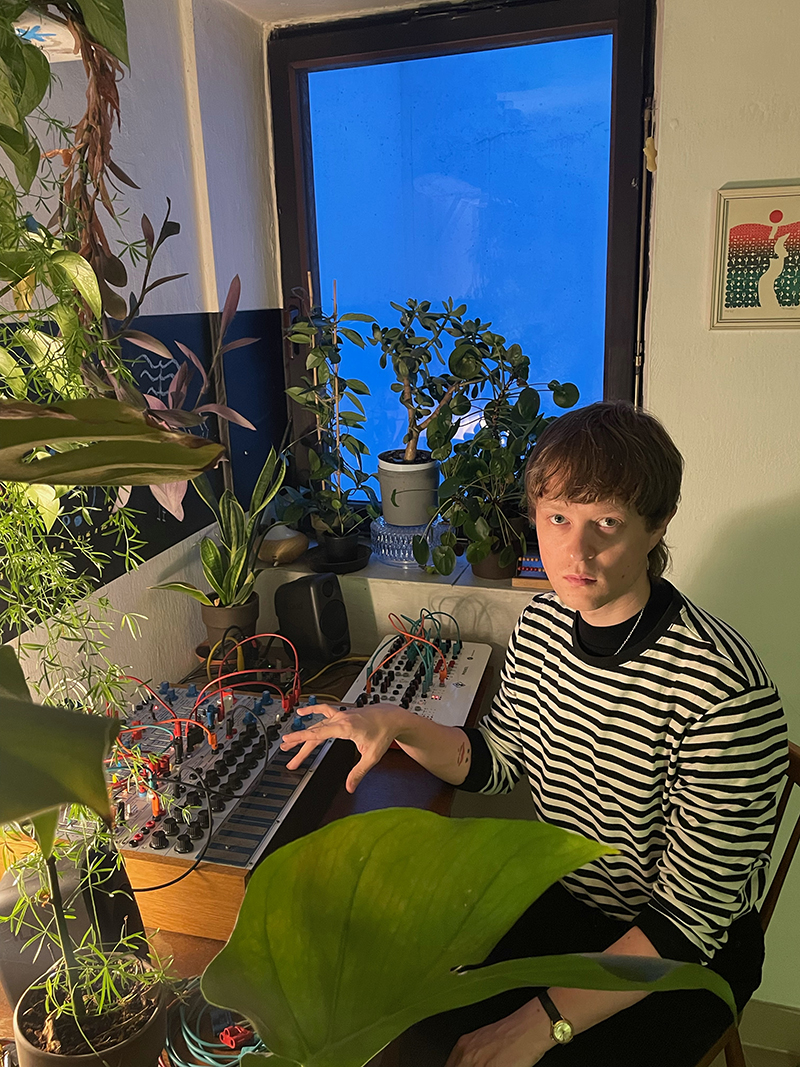
21. Ensamble De Incertidumbre – Funciones C (04:54)
22. Ensamble De Incertidumbre – Funciones D (02:46)
Recorded at La Siesta Del Fauno, Buenos Aires, 2021.
Technical assistance: Guillermo “Billy Shears” Costa & Rocío Cimmino
Ernesto Romeo: Buchla Serie 200e Modular System + Nothern Light, DOBOTZ & 1979 modules. Serie 200 Modular System
Agustin Aguirre: Music Easel + Moog Minifooger Analog Delay (modded).
Francisco Rehmann: Serie 200 Modular System & 208r Easel Panel, DOBOTZ & Voltage Circus modules.
The Ensamble De Incertidumbre was formed in 2021 as an exploratory grouping of the expressive possibilities of Buchla philosophy systems in the context of real-time composition. Each Ensemble jam seeks to deepen the dialogues (and trialogues) between human gestures and intentionality vs. electronic gestures and intentionality.
The main attraction for us is in the proposition of the modules and systems, which manifest a vision of artistic emancipation through electroacoustics that is a reflection of a peculiar and distinctive light of the Buchla philosophy of what musical creation with electronic media means. It can provide form and expression.
Listening to the « Buchla sound » we felt the deep personality that an electro sonic organism is capable of manifesting.
We hope to propose alternative paths to decode certain music that is resonating in the cosmos waiting to be transduced.
Favorite Buchla modules are the 266 Source Of Uncertainty for the infinite amount of probabilistic and random control signals it provides to give life to synthesis systems. Secondly the Music Easel for integrating electronic resources into a simple instrument that can become natural extensions of the performers
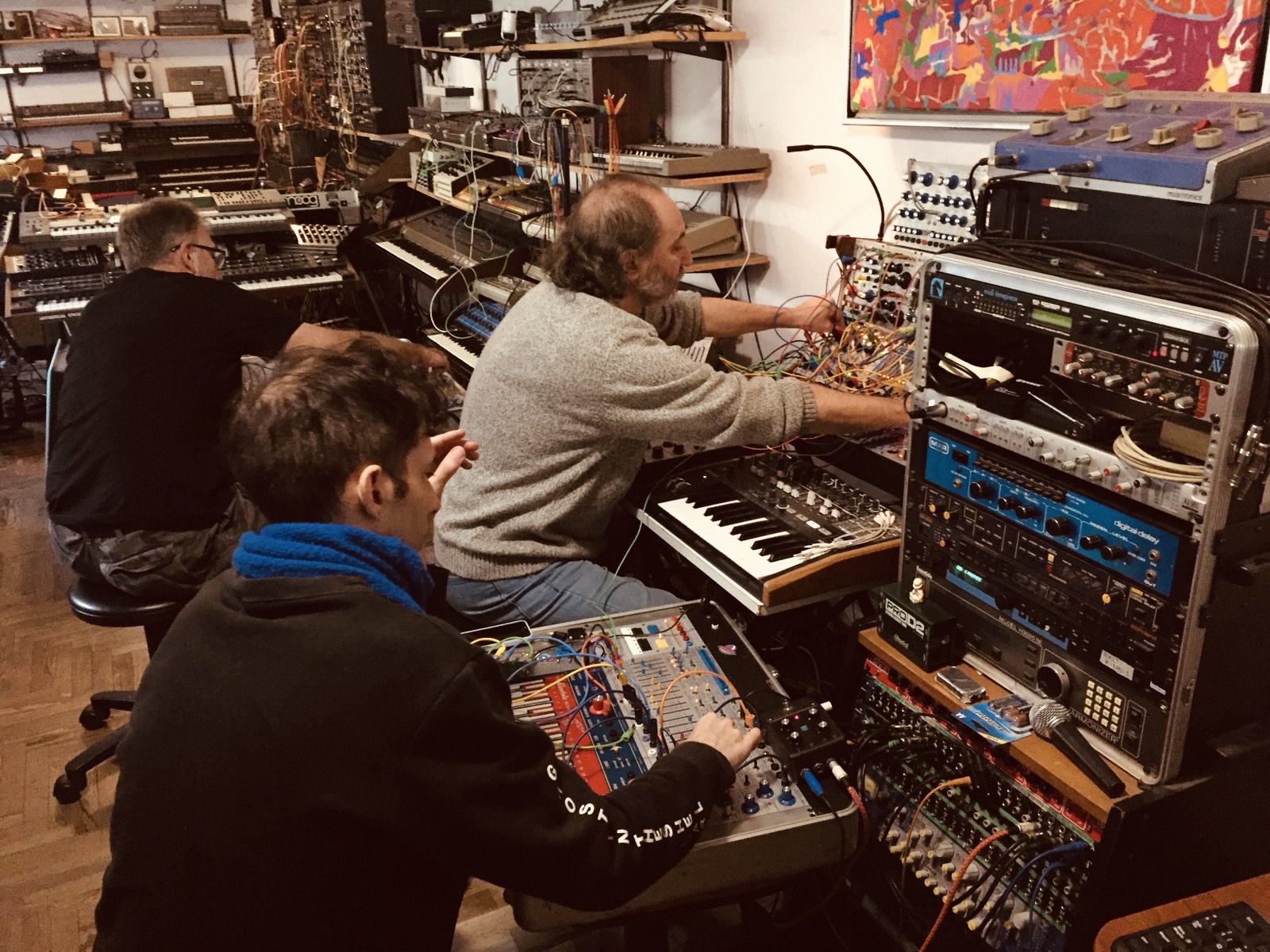
23. Mockingwyrd – Autumn Fog (02:16)
Mockingwyrd is Topi Aarnio, the bass-wielding fuzz-monger in the band Fuzzifer, but also Buchla-abuser in said band and at home.
This short piece happened in September when the sea was abnormally warm for the time and the nights were already getting colder. I woke up to see the fog rolling in and decided to try to capture some of that feel in sounds.
I was initially attracted to the Buchla instruments because of their looks, the very clear layouts and then I heard The Tobor Experiment’s album “Tales From Dione”. When I first tried out a Buchla 200e I could hardly even move any knobs, I was so fascinated by the tones that were already set up on that system.
After I got my very small initial setup, I fell in love with patch storage and being able to change sounds quickly, which is very handy especially when performing with a band and handling other instruments too. Otherwise the 259e is a never ending source of wonder for me and now that I have finally gotten the 291e too, it seems like I get lost in those two modules and forget everything else.
I use the system mainly in two ways: capturing a feel and going with the flow, or making sounds for my bands and then using them alongside my bass.
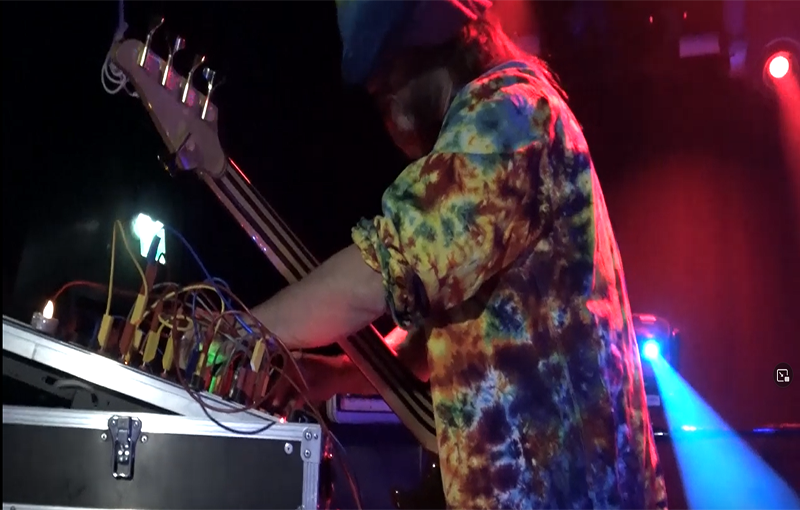
24. Luca Manti – Nasce l’alba (03:52)
Luca Manti started as an upright bass player and immediately became fascinated by free jazz, which he practiced for some years. He then ventured into the world of experimental electronic music, where he found his voice through modular systems.
This track took me some time to make, as I am in a transition phase in my life.
As many of us know, this can be beautiful, terrible, frustrating and so much more. Because of that, my inspiration and motivation to play and create have gone all kind of directions. So maybe this is the inspiration for the track?
I had only scratched the surface of a little Eurorack system I had put together before I decided to move into Buchla, seduced by its sound and format. After I discovered Keen Association, I managed to put a little Keen system together, which has been my main instrument for the last 4 years.
My favorite module is the 224e controller. Without it, I would have no idea of how to make my system sing as it does when I’m using it. The fact of being able to change the pitch, amplitude in such a delicate way seems just magical. Also, being able to map the three separate CV out, connected to the X, Y, Z axis, to filter frequency, modulation’s etc. is wonderful.
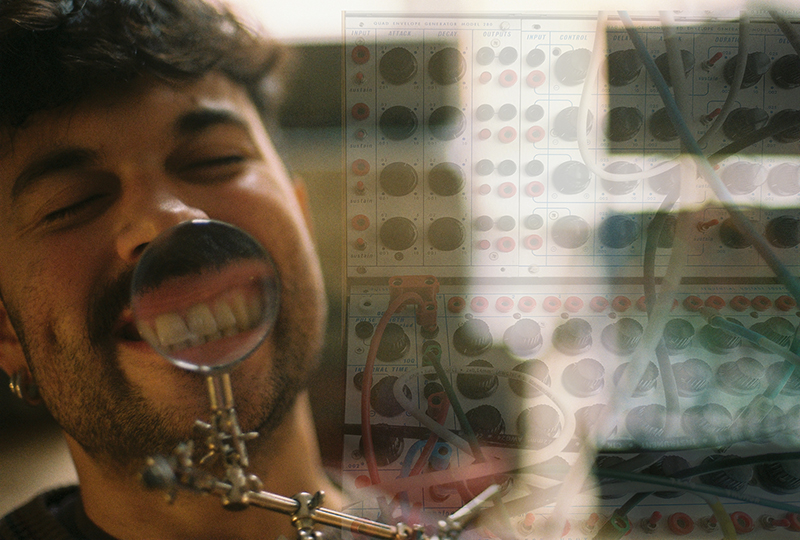
25. Kevin Rix – The Thing part 2 (25:06)
Kevin Rix studied orchestral composition and started to feature music in film and tv trailers.
“The Thing” was born out of the 2022 summer sessions when I was obsessed with cosmic horror sci-fi movies like The Thing, Color Out of Space, Annihilation, and Invasion of the Body Snatchers. I used them as inspiration to capture the complex emotions of what it might feel like to witness a more evolved alien species envelope all life on earth. The Buchla is great at evoking a kind of beautiful terror, as the sound of the 200e can be cold, aggressive, and distant. To me, the West Coast cross modulation and the natural aliasing from the digital oscillators overdriving the input and output circuits create a sense of DNA being ripped apart and reformed into something completely different. All thoughts, memory, and trace of our existence on this planet absorbed into a new life form.
For this session, I came up with a patch using a modified Buchla Skylab. It’s pretty stock except for a 250e in place of the 251e and iconic 223e. I also allowed three extra cables to create spontaneous additional patching and used a Strymon Nightsky for reverb effects. The patch stayed the same all summer as I recorded different sessions. I was intrigued with how much variation could be achieved within one patch.
The Skylab really hit me in a profound way. I was fascinated with it. There was something in the sound that I’ve never heard before. I love the otherworldly quality and pure expression of the soundscapes it produces and wanted to explore this as much as possible.
I sample Buchla quite a bit for my film trailer work. I organize and keep everything handy when I need some weird signature sound or atmosphere. For my personal use I like to come up with a patch with the sound off, then hit record and discover it in real time. My day job requires tons and tons of tedious editing and mixing practices on the DAW, so when I work on modular stuff I like to record Buchla in one take with mistakes and all. I feel music is way too overproduced these days, so I like to keep it as simple as possible. Buchla is my creative vacation away from the DAW.
I have quite a few favorite Buchla modules but right now it’s the mic input on the 227e mixer module. Sending real world sound into the system is pretty awesome.
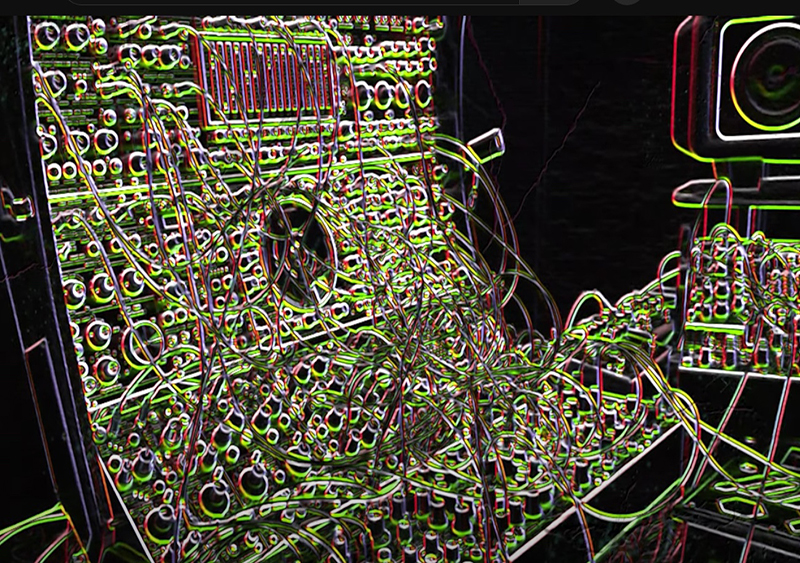
26. ANGST Sessions – From Beyond (05:28)
ANGST Sessions who make Dunkel Kosmische Musik out of the dark forests of Sweden have released 4 records.
I played around with my WAD and 288r together with the Magnetic Freak Gaussian and Eardrill 077 Pendelum / ratchet modules and these combined can fairly quickly become way too dense and chaotic and I wanted to slowly build up and play around with spatial space and timing while still have room for different timbres and feedback. So I found something I liked and tested out different ways to build up the track and also being able to control and play along which is hard sometimes when having feedback in the patch. So I just pulled out a lot of banana cables and dialed back settings and just went along when i started recording – basically just followed the sound and added more and more – of course forgot some things and in the moment added and tried new stuff and towards the end tried to end the song. So this is all a one taker with some added EQ and reverb in my DAW.
I fell in love with the aesthetics and sound of the Buchla from early adopters like Susanne Ciani and Morton Subotnick. The Easel was the first one I really wanted since the bigger 100 and 200 systems were in universities in The USA or EMS studio in Stockholm so they felt completely out of reach. I also like the form factor and that it is its own closed system that is so well thought out. Banana cables are a big plus and I just like that the old 200 system is completely without any kind of menu diving.
First time I heard a Buchla for real was when I bought a used Bemi Easel in 2017. I got blown away by the Oscillators and LPG´s – those Buchla Bongos… That instrument still amazes me and the way I can control the shape and tone of sound while having a lot of controlled randomness is just pure genius. Of Course a 200 system gives me more of Don Buchla´s vision and I feel like I have a lifetime of joy and exploration with this modular instrument. The sound is one thing with buchla but the way you interact with the modules is very special and my head keeps coming up with ideas even though I am not in front of my Buchla.
I had a 200e system since I wanted to try also this era of Don Buchla’s vision but in the end it was not how I want to work at all – its functionalities are great but not for me. So I have put together a 200 clone system (thanks to M.E.M.S and my builders) that consists of MARF, 223e, Magnetic Freak Gaussian, Soundfreak EMS Oscillators and Filter, 266, 258M, 259M, WAD Delay, Studio H 254e, 292c, 281D, Eardrill 077 Pendelum / ratchet, 284, 292 Resonant, Keen 228e, 288r and 296M. I like having tons of synced triggers and also play with timing / polyrhythms and doing quite simple sequenced stuff and getting an atmosphere often quite slow and I am really trying to have space between notes so I can play with different timbre / feedback and give it some spatial space… My desire is to start exploring quickly, starting up and go deeper with some vision I have and when I find something I like I try going to extremes and dial back and forth to find out where the sweet spots are for my vision (that sometimes changes during my session) and then I am ready to record – I now have 4 mono or 2 stereo out that goes into my DAW which gives me some fun later when I make my EQ and some volume/ pan plus adding reverbs in my DAW but its a one taker that I am using and I never chop things up or so. I will get an extra 207M to get more channels in and out of my Buchla.
I always use 259, 266, 281 and 292 plus the 258. Those are the basic fundamentals. Favourite Buchla module I would say is either the 259 or the 248 MARF. 259 for its layout and sound, which for me are the best sounding oscillators I know. The MARF I have is using the latest community firmware which works just great and being able to interact so deeply with a sequencer or function generator as Don calls it is just fantastic. So extremely well thought out and so far ahead of its time plus being able to use his modern 223e together with the MARF opens up new possibilities.
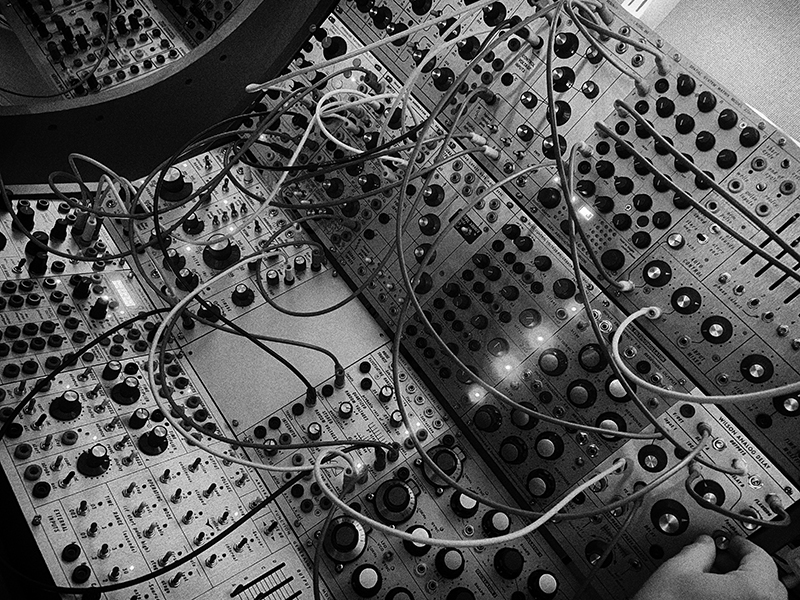
27. Roland Kuit – March of The Times (03:48)
Roland Emile Kuit’s artistic path is undeniably marked by a persistent desire to redefine the horizons of sound art and composition, a post-genre composer, sound and music theorist, author and lecturer in the field of sound design, electroacoustic music composition and sound art. Trained by Gottfried Michael Koenig, Jaap Vink, Werner Kaegi, Paul Berg, Frits Weiland and Stan Tempelaars at the Institute for Sonology in Utrecht. Followed by private lessons with Dick Raaijmakers. His research and sound design include: Kyma – Pacarana, Buchla 200, ARP2500, Max/MSP, SCOPE SDK6 Xite, Modular IV, Xite-1, Clavia NMG2 & Nord Modular, KLC MS -20, Interactive Sonic Spaces, FORTRAN IV, Voltage-control Studio (BEA 5) and the PDP-15 computer, MIDIM/VOSIM at the Institute of Sonology, ARP2500 and the ARP2600.
The world has so many front lines, I couldn’t help but think of the works of Charles Ives. An American composer who created the musical illusion of multiple marching bands marching through each other as clashing bands. The unlawful and inhumane war that Russia has started in Ukraine is directed against the entire civilian population and is causing chaos in our worlds. That has to stop.
The state-of-the-art Buchla synthesizers, almost entirely handmade, are unique in their kind. All modules have an innovative and individual character that enriches the sonic realm, as I noted back in the 70s.
I created these sounds with my favorite modules. The Model 259 Programmable Complex Waveform Generator for using timbre modulated FM patterns. I explored new possibilities for timbre modulation using the Frequency Shifter / Balanced Modulator Model 285 and created chaotic patterns using the Source of Uncertainty Model 266 in conjunction with those 2 modules.
The Kyma Pacamara was used for the after effects.
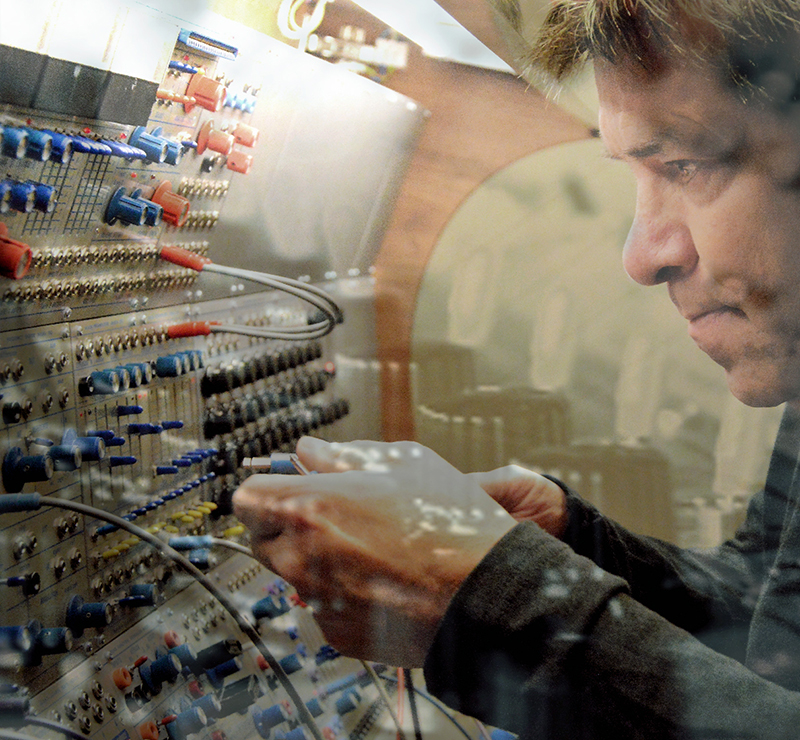
28. Emanuele Nanni – Stridore (05:41)
Emanuele Nanni is a sound artist and composer based in Parma, Italy.
His music and performances belong to a rational and methodical approach that coexist with the paradigmatic essence of his main instrument: a Buchla format electronic instrument he has assembled.
Deep and seething basses are the ground for sound textures always in movements where harsh and unexpected sounds alternate with solos and insistent rhythmic sequences typical of more structured compositions.
His concept is the intentional accident of a purely classical culture immersed in an uncertain and dark modern framework.
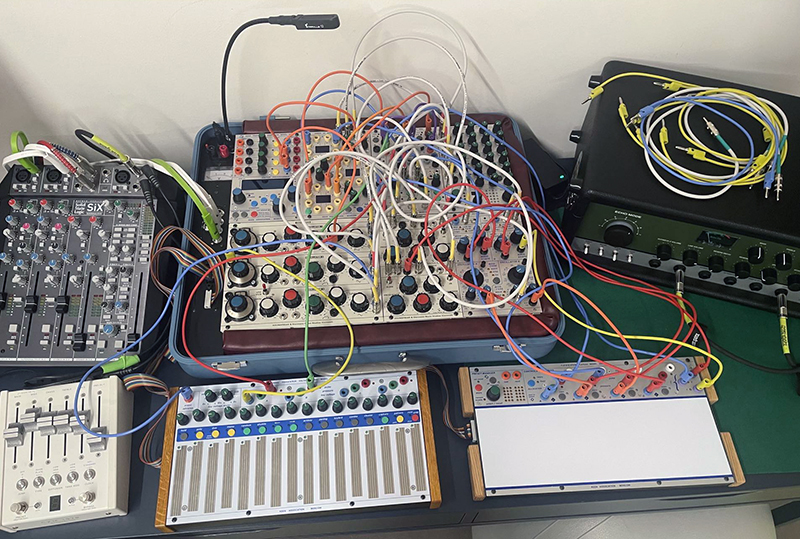
Benge – Euclid’s Wheel video
Euclid pointed out 2300 years ago, a wheel is not round when viewed from an angle This piece started life as an exploration of the Buchla MARF’s ability to play two concurrent sequences of different lengths. I set up two Euclidean Rhythmic patterns (E-7/12 and E-3/8) and then added further modulations using the Buchla 208 5-step sequencer. The overall effect is one of polyrhythmic complexity, aided by this instrument’s plethora of interconnectable options, including panning, random voltages, frequency modulation and shifting, phasing, envelope following, and filtering It would be impossible to list all the pathways that were involved in this patch, but the general idea is one of Euclidean Rhythms, and the perception of cycles, circles, ovals and wheels within wheels Note that this patch makes use of the special yellow banana cable that Don himself gifted me when I was in his workshop many years ago. I treasure the yellow cable, I believe it holds some magic for me when patching his amazing system.
